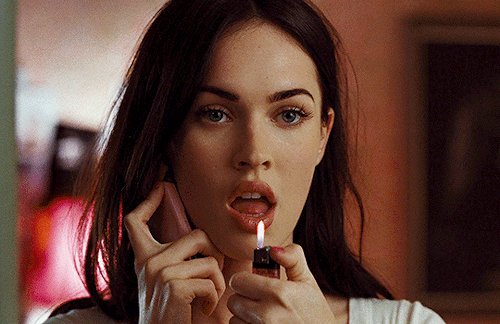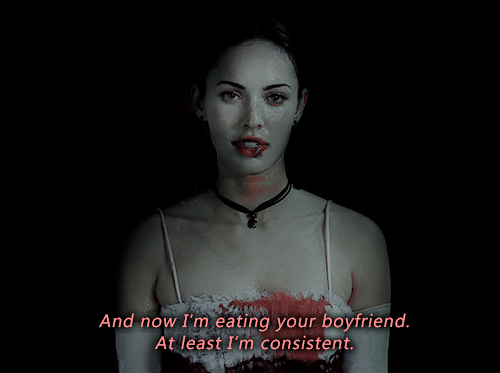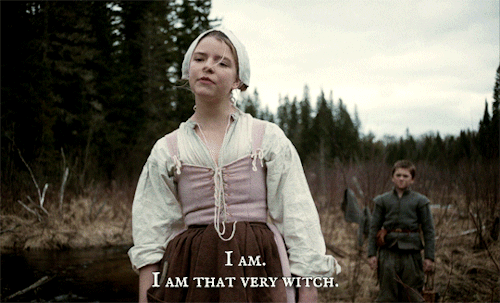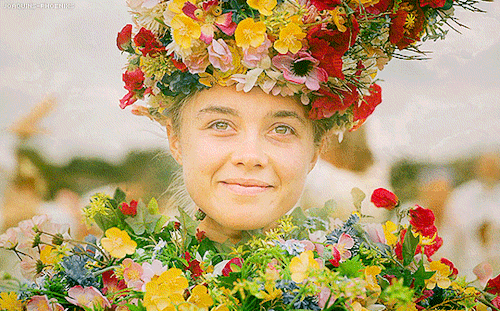Women and the New Wave of Horror
It has long been the case that horror movies were produced under the assumption that the audience would be primarily male. For as far back as horror cinema has been created, actresses have played victims, tantalizing male viewers by stitching together the twin obsessions of sex and death. Yes, some have played villains, though primarily they represented the smothering mother figure (Psycho, Friday the 13th) or the much-feared castrator/vagina dentata (Misery, Alien). The “strongest” female figure we traditionally encounter is the “final girl,” the one virginal, moral figure who somehow lives through the bloodbath, outwitting the evil. Men are evil and debased, male viewers are expected to accept that. Most women are evil, immoral sinners as well. But the rare pure, chaste, and moral woman represents the highest purity and for this, she is allowed to live. Her job is to mete out justice while remaining pure, untouched and untouchable. This character must be a woman, because a man’s life in danger is simply not as frightening as a woman’s, since he is conventionally expected to be the subject of violence. And while she might at first glance represent some kind of feminist hero, outliving all the supposedly-strong men, the Final Girl’s slut-shaming condemnation of her peers is distinctly old-fashioned and leaves most modern female viewers in the confusing moral position of hating the story’s protagonist. Therefore it can be no surprise that in the modern wave of horror films (let’s frame this as movies created in the 2000s), the female/not-cis-het-male viewer is not only considered, but is often prime intended audience.
The Birth Of The New Wave Horror Film
I believe that this “new wave” of horror began with 2009′s “Jennifer’s Body,” written by Diablo Cody and directed by Karyn Kusama. Before this film hit theaters, horror movies were floundering, attempting to make box office hits by being as “terrifying” as possible. The 80s had seen the hayday of the slasher, the 90s had some innovative hallmark hits that nonetheless did not stray far from the slasher format, and then in the early 2000s, horror was primarily dead. Aside from being a way to put young couples in seats by scaring them into one another’s arms, horror had lost much of its power, once a tool of political commentary or artistic cinematic agenda. The biggest news in horror before “Jennifer’s Body” arrived on the scene was 2003′s “Paranormal Activity,” marketed as “the scariest horror movie ever made.” Jennifer’s Body was truly different. Though it met initial lukewarm reviews and at the time wasn’t the big jumpstart the horror genre needed, retrospectively it is a hallmark of horror movie styling and a cult classic to be watched at teen girl sleepovers for many many years to come.

Jennifer’s Body tells the story of two highschool girls, Jennifer Check and Anita “Needy” Lesnicki. The two childhood friends are hanging out at a local dive bar when an emo band passing through town spots hottie Jennifer and decides to sacrifice her to the Devil to make it big, under the impression that Jennifer is a virgin. Well, Jennifer lied and the sacrifice goes horribly wrong. A demon possesses Jennifer and goes on a rampage, seducing and killing boys for food and sport. Throughout the story it becomes clear that, while Jennifer may have been the more attractive and popular of the two girls, “Check”ing all the boxes of ideal womanhood, it is Needy who has a boyfriend and is living independently and happily. It is actually Jennifer who is “needy,” relying on her one best friend for comfort and consistency, and probably also harboring a crush on her. Her rampage of seducing and murdering boys speaks to a more realistic need to go through men as a way to act out the feelings of instability in her life. She appears perfect, beautiful, to have it all, but really she envys Needy’s humble and comfortable life.
In conversation with Megan Fox for the 10th year anniversary of Jennifer’s Body’s release, Diablo Cody expressed frustration with the movie’s marketing. She had initially intended the film for an audience of young women, not hormonal teenage boys and lusty adult men looking for the cheap thrills of a Megan Fox-Amanda Seyfried kiss scene, as the production company eneded up doing. The movie about a cheerleader devouring boys had been written by a women, directed by a woman, starring two women in the lead roles, with a title derived of a feminist grunge anthem, and yet somehow it had been presented to the world as another safe way for men to explore their ever-present castration fear/obsession. It had been handicapped by whispered gossip about Cody’s past as a stripper, Megan Fox’s reputation as an air-head hottie, and a snappy black-comedy script rife with early 2000s teen-isms. But even if the movie had not worked out the way it was planned, it still hallmarks the new wave of horror in that it is a horror movie intended for a female audience. Where Needy could be seen as fitting the moral “final girl” trope, she actually has sex (major final-girl no no). She has a great relationship with her boyfriend, in fact. No one thinks it could be possible that the beautiful, popular Jennifer Check could ever be the one who envied humble, homely Needy. In the end, Needy escapes the psych ward she is imprisoned in and hitchhikes to a motel where she murders the emo band that turned Jennifer into a demon in the first place. By uniting demonic Jennifer and “final girl” Needy’s enemies, we can no longer interpret Jennifer as the true villain of the story. Rather, she was the victim of the men who used her body to climb to fame, and the universal enemy of the movie is men.

Since Jennifer’s Body, more horror movies have emerged with a focus on women, and not just as a victim or a final girl. The 2010s has particularly seen the renaissance of the horror genre, retilling its once-fertile soil and planting anew with psychological plotlines that leave behind freudian phallocentrism and delve into themes that haunt most modern women: perfection, beauty, fame, motherhood, sanity, and identity. The end vignette of Jennifer’s Body, in which a woman lives and in fact triumphs over her enemies at the expense of her sanity and/or morals, has become a mainstay of the genre. The new-wave horror film acts as a haunting meditative reminder that women cannot exist in the patriarchal world the way they are asked to. That they will be persecuted, used, forever imperfect, or else they will be forced to the fringes of society, forever the witch who lives in the woods on the outskirts of town. Two films that explore this particularly saliently are 2015′s The Witch and 2017′s Hagazussa.
The Witch Mythos
In Egger’s The Witch, a puritan New England family are banished from town for differing in their religious beliefs. Their new home is soon beset upon by a literal witch in the woods. Is she a punishment from God? Is she nature (The Devil) taking revenge upon the influence of the intruding settlers? One by one their infant son is stolen and killed by the witch, and then their adolescent son is seduced and bewitched by her before being killed in an orgasmic religious display. The young twin siblings, who share some kind of friendship with the black billygoat the family keeps, are reduced to hysterics. The mother of the family hallucinates herself to be feeding her infant child at her breast while her heart is pecked at by a raven, the witch’s familiar. The family’s crops, the father’s purview, fail. The only person who seems untouched by the witch’s curse is eldest Thomasin, who soon finds herself accused of doing dealings with the Devil and bringing his influence down upon the family in order to protect herself. In truth, it is Thomasin who is moral and pure of heart, and her family who are the sinners. The baby is perhaps an unbaptised child, the young brother is suffering adolescent lust, the twins disobey their elders and speak to beasts, the mother is wrathful, and the father lies. Only Thomasin is free of sin, and yet she is the center of the literal witch hunt. In the end she must kill her mother to save her own life and she witnesses her father gored by Black Phillip, the family goat. She is left alone, hysterical that godlike living and religion did not save her or her family from persecution, devoid of faith. With nowhere else to turn for comfort, no other family remaining, she signs The Devil’s book and goes to the woods to be with the witches, the other women who have found society too hostile a place to inhabit, and found no comfort in God’s love, and there she “ascends,” learning to fly.

Hagazussa is similar, telling the story of a sinless child with a heathen mother who live far outside town and are taunted by the townsfolk. After her mother dies of a mysterious illness and a brief insanity, the young woman Albrun is left alone in the cabin far from town. After a time jump, Albrun cares for a child and we know nothing of the child’s father. We see her enjoying a lonely pastoral life, masturbating amidst her herd of goats while showing them affection. She brings her mother’s skull home from the local church at the behest of the parson there, to remove heathen influence on the town. Later, Albrun’s trust is betrayed when a young woman from town who comes to visit her tells her that heathens will come in the night and attack women, and a few months later they mysteriously bear a child. Likely to “cure” her of heathen influence, the woman organizes for Albrun to be correctively raped by a Christian man. In retribution Albrun poisons the town’s water supply. When she sees the dead bodies she has brought about, she eats a hallucinatory mushroom. During the trance, she enters a pond and drowns her child, presumably trying to purge the object she sees as the source of her evil, her “heathen” goat-child. Waking up in her cabin later in a state of confusion, the empty eyes of her mother’s skull watch as she puts the child’s sodden body into a stew and eats of it in a depraved and regretful attempt to reincorporate the child into her, perhaps to invite it back into her womb. Then she throws it back up. Shaken, Albrun ascends the mountain and lays down, her body destroyed by the light of the rising sun.
Both movies address the “witch” myth, the idea that women, inherently sinful, must be doing dealings with the devil. In the past, the witch has been depicted as an old hag living an isolated life, a woman who never married. They steal children, presumably because they will never have children of their own. Mostly the witch’s goal is to prolong her own life by consuming the innocent, likely playing into the age-old idea of the primordial mother, one who represents both birth and death, the black void from whence we all come and to which we must all return (We can look to Melisandre, the Red Lady, from Game Of Thrones, as a perhaps hamfisted adaptation of every facet of the witch myth). These are not the comforting arms of the caregiver mother, but the wicked woman who smothers children, steals them, returns them to the void. She is the seductress and castrator, stealing men’s power and potency. She horribly ugly or scary, but tricks men into falling for her with a beautiful mask. Women have been suffocated by this witch mythos for a long time, having their traditional professions as healers, midwives, religious leaders, and wisewomen wrenched from their hands by men who feared their power. The new wave horror movie shows us the witch we have always feared, but this time gives her a motive, shows her descent into madness and cruelty and lays her evils out as justified, striking back against a world that would not have her. She is, for women, a comfort. Our ancestors were strong and powerful women, too wild to hold, and they allow viewers on the fringe to recognize themselves and get the second-hand experience of revenge against oppressors. For male viewers, she is a reminder of a threat. A woman cannot be forced into societal corsetry, for all the pressure will form a diamond sharp enough to slice back against any bonds.
The Empress
The occult and visions of a “coven” seem intertwined with women due to the witch myth. If the patriarchy turns women against one another, competing for Most Beautiful and Most Sexy and Most Pure, the coven represents the support of peers, of complete acceptance with no judgement. There does tend to be a hierarchy to coven imagery in the modern horror film, oftentimes converting the heroine to The High Priestess, and I believe this has to do with the audience’s identification with her. She is not accepted in the outside world. She is crazy, too sexual, not sexual enough, not pretty enough, too emotional, too intelligent, too strong willed, etc. In the coven she is the Most Powerful Woman, the archetype of perfection, and this has a lot to do with us, the viewers, wanting the satisfaction of perhaps being “insane”, but being accepted and loved not just despite it, but for it. In both 2019′s Midsommer by Ari Aster and 2018′s Suspiria remake by Luca Guadagnino, Dani and Susie, who are othered and isolated, find homes and arms to welcome them in their respective covens. And both young women are broken over the knee of the wickedness of their coven-peers, forced to reign under a new morality that has nothing to do with the strict ways of the outside world.
In Midsommer, the movie opens with Dani discovering that her whole family is dead in a murder-suicide enacted by her sister. Its an inconceivable tragedy, and Dani mourns, suddenly left completely alone in the world except for the company of a rather useless boyfriend named Christian (HELLO). When she finds out he and some college friends are taking a trip to Sweden to experience the midsummer rituals of a pagan clan there, she convinces her boyfriend to bring her along for a change of pace. For the most part, Christian’s friends are none too amused that an over-emotional, dependent Dani is going to be weighing down their summer plans. It doesn’t take long after arriving for the group to start having uneasy feelings, no thanks to a welcoming mat in the form of psilocybin mushrooms. The group witnesses the death of two clan elders, jumping willingly from a cliff at the age of 72. The older man dies, and the whole clan mimics his cries of pain until he is put out of his misery. The Hårga insist that this is less barbaric than it looks, that every member expects this and anticipates it as a welcome into the next life. However, naturally our American tourists are stunned. The movie goes on, and, amid a backdrop of conflict between the tourist group, they are slowly picked off one by one. When only Dani and Christian remain, Dani is whisked off to participate in a psychedelically-enhanced Maypole dance, and Christian is subjected to a bizarre sex rite involving dozens of Hårga women. During this scene, we once again witness the cult’s tendency to act out what other members are feeling, moaning along with the girl Christian copulates with. Dani wins the maypole dance and is crowned May Queen. She wonders where Christian has gone and witnesses him partaking in this bizarre ritual, an orgy with a crowd of strange women. Upon witnessing the betrayal, she has a panic attack and, once again, the Hårga women join in by wailing with her. The cult announces that to culminate the Midsommar celebrations, nine human sacrifices must be offered. 8 of these have been taken care of in the form of the dead elders, the slaughtered tourists, and some volunteering cult members, Dani just has to choose the final sacrificial lamb, and she chooses Christian in twisted revenge. As the cult watches the building containing the sacrifices go up in flames, they join together in a chorus of wails to echo those of the suffering inside. Dani’s distraught face slowly cracks into an insane smile.

The Hårga are presented as light-worshipping flower children, and while they are this, they also follow a set of morals and religious rituals that make no sense to viewers or to the American tourists in their midst. Dani, who has just experienced the most horrific and unexpected death of her parents and sister, is suddenly forced to view more death. It could break her, and in a way it does, but it is also comforting. These clan members didn’t die unexpectedly, they knew their whole lives what was going to happen to them and watched presumably hundreds of others experience the same thing. Death isn’t a putrid thing to look away from anymore, it is something to be experienced as a group and mourned as a group. It is something that you look right into, in the broad light of day, and this was just the soul medicine Dani needed after being left alone with the deaths of her family members.
The true horror of Midsommer, though, lies in the fraught relationship between Dani and Christian woven between the abject horrors of the cult. While Dani seeks support in her time of need, Christian is largely concerned with his friendships with his college mates. When she finally expresses frustration with him, he turns the tables on her and forces her to shrink and recant or risk losing another relationship. Christian is not outright mean, he is just ignorant and has no space for his girlfriend’s needs. The magic of Midsommer is the revolutionary positioning of a woman’s emotional needs as reasonable, human, and sane, and the boyfriend’s shrugging her off as cold, cruel, and ignorant. In the past, a woman’s emotional state was framed as hysterical, clingy, overreactionary, When Dani wins the position of May Queen, she is suddenly the center of a group of people who adore her, who weep with her and celebrate with her, who understand her innately despite language barriers.
Susie Bannion, the lead character of 2018′s Suspiria remake by Luca Guadagnino, has a slightly more mysterious beginning. We learn through flashbacks throughout the movie that Susie came from a Mennonite or Amish background, and yet she arrives at Markos Dance Academy in divided Berlin already a talented modern dancer. Something drew Susie across the ocean from the middle of nowhere to be a part of this dance company, which is secretly run by a coven of witches, and somehow she managed to study dance from within a religious world that forbids it. The head of the coven, Helena Markos, is dying and needs Susie’s power as a way to regain strength. However, there seems to be some kind of fissure in the dance school, with some of the teachers/witches believing Markos to be the rightful leader who should be aided in regeneration, and others standing behind Tilda Swinton’s Madame Blanc as the successor to the throne.
Susie arrives at school kind of awkward and matronly. She is very conservatively dressed, except when she is dancing and becomes outwardly sensual. In a movie very deliberately filmed in muted, flesh-like ecrus and greys, Susie’s red hair stands out and connects her to feminine power and magic, and the red motif continues to represent these ideas throughout the movie. As Susie and Madame Blanc grow closer and Susie’s real talents start to blossom, she begins borrowing more stylish contemporary pieces from her friend Sara’s wardrobe, and becomes more comfortably integrated into the dance school.
In the culmination of the film an unholy ritual is held, ostensibly to pass the rotting Helena Markos into Susie’s youthful body. However, it quickly becomes apparent that all is not going according to plan, and Susie releases the abomination that is Mater Suspiriorum upon the room, revealing that the mother witch has resided within her the entire time, and that she is the successor to the throne, not Markos or Blanc. Mater Suspiriorum and Susie dispense of any of the witches who do not support her reign, as well as putting some tortured sacrifices out of their misery with motherly adoration. All around her, surviving students and teachers writhe in satanic dance, and Susie takes her rightful place as head of Markos Dance Academy and the coven.
Suspiria has perhaps less of a feminist message than Midsommer, the enemy not being men so much as patriarchal ideals on the whole, but it is also a story of a woman coming from a place of powerlessness and rising to her position as Empress. In this case, the more Susie can let herself go, cast off the bonds of her Mennonite upbringing and embrace her sensuality, the more of her true power is revealed. The vehicle for the film is dance, and at a school for girls no less. The scenes featuring the female students are generally not sexualized (unless pointed sensuality is the purpose of the scene), and are instead rather fashionable and capture the imagination. In fact, in one scene the witches of the coven are seen emasculating a pair of stunned policemen and making fun of their self-perceived power when the truth is that they could not be less in control. It is, on the whole, a story of an oppressed woman casting success in the faces of those who may have doubted her, even if the cost was her humanity, her family, and perhaps her sanity. Though this film is gripping and entertaining for viewers of any gender, it is not a particularly masculine film, and has found its place in the hearts of many female (and otherwise not-cis-het-male) viewers.

——
The horror genre has evolved to become a unique place in which women can find their power. If the patriarchy fears the self-actualised powerful woman, then a horror film is an excellent way to play to these fears and push the possibilities of what that could look like. It may not come naturally to consider the insane, all-powerful, perhaps murderous female criminal a heroine and a role model, but indeed she does end up embodying this role for most viewers, if the movie has done its job correctly. We are meant to find sympathy for her and feel justified when she goes on a murdering spree, for all those of us who are not empowered by the white male preference have felt the desire to see him ripped to shreds or taken to justice at one time or another. It offers catharsis, empathy, validation, and fantasy to those who, for a long time, have felt the superhero movie and the churned-out, placating feminist messages of mainstream media too pandering and alienating. There is a freedom offered to the horror genre to not play to awards season appeal, since horror movies have been notoriously snubbed at awards shows. Therefor, the horror movie has more room to play to the fringe audience, those who feel disenfranchised or othered by the mainstream media. Indeed the new wave of indie horror films that have been gaining popularity since the early 2000s is defined by its tendency to be produced by and for women, people of color, or anyone else who needs film to watch a white man get what’s coming to him.